Summer Blast from the Past: A Journey through 1970s Swimsuits in Croatia (PHOTOS)
August 11, 2022 - A summer blast from the past brought to us by the Nikola Tesla Technical Museum in Zagreb. Check out the 1970s swimsuits in Croatia!
"Summer gives birth to new people...harmonious, unrestrained. Pristinely beautiful. Between air, water, and sun. A swimsuit is part of them. Their ways. Their beauties." reads an advertising brochure used by the Varaždin VIS factory in the 1970s to entice customers to buy its swimsuits.
Swimwear has undoubtedly evolved throughout history, and many new swimwear trends are met with outrage - well, compared to the swimsuits of the past. The Nikola Tesla Technical Museum has thus published a series of photos of how 1970s swimsuits in Croatia looked, where they were bought, and how manufacturers lured customers to buy them.
The first Yugoslavian swimwear and terrycloth show was held at the Hotel Slavija in Borik near Zadar at the end of March 1970. The collections presented by the manufacturers were distinguished by 'exclusive designs' and 'very stable colors,' with the women featured being very attractive and feminine.
In addition to Lisca, another participant in the show was the Varaždin VIS factory, which at the time even offered to make custom designs on orders. Umbrellas from the VIS factory, which cost as much as a vacuum cleaner (a fifth of someone's month's salary back then), were taken to the beach, ALKA Frigoterm small portable coolers made by Jugopastika kept food cool, while Badel's Nara or Inka or Droga's Fla-Vor-Aid were the drink of choice. Coppertone Tropical Blend from Belupo or Nivea from the NEVA factory in Zagreb was the go-to sun protection brand.
START Magazine wrote about what a summer vacation looked like in the 1970s: "Vacation is not only about relaxing the body but actually activating it. A man in his seventies is mature enough to go to the sea, sail, and find his bay. The era of tourism with air mattress man is passing. People no longer come to the sea to gain weight but regain some of their elasticity and adventure.'
New water activities then included water skiing, windsurfing, and fishing. In 1979, swimming was a skill practiced by 75 percent of respondents in Croatia, more often men than women and younger than older.
Although no one was seen wearing thongs and bikinis at the time, these new swimwear trends caused disbelief, which is best described in the text below:
"The intense heat, which prevailed at the beginning of the month and forced the mercury in the thermometer to an unusual height, so to speak, lured all of Zagreb to the Sava. Especially on Sundays, the number of people from Zagreb on the Sava reaches ten thousand! Everything bustles here, everyone mixes, enters the water, and from the water to the sand to sunbathe. From small children to the elderly, everyone left the city to cool off in the silver foamy waves of the Sava. Even if the city's swimming pool is huge, and Gospodarič's has been enlarged, it is still too small to accommodate so many bathers and provide everyone with a cabin. Many come and can't find a place to undress; they are forced to swim further west of the city swimming area. Life at the swimming pool faithfully reflects Zagreb and all its citizens. Many of them have lunch at the swimming pool, then go to homes or restaurants in the afternoon to have dinner, from the Sava through Zrinjevac to Maksimir and the pleasant and quiet courtyards in Gornji grad.
It's no wonder that at the crowded Sava swimming area these days, feinschmeckers or gourmands, precisely gourmands, enjoy looking at the young women, those golden fishes, Nymphs, and Sirens in the silvery waters and sigh to themselves: Ah, ah and ah! So they go for a beer so that the wishes live on! That's why the well-dressed older ladies are outraged by today's women's swimsuits. Today, women are almost naked, and when we were their age, we had full bathing suits and socks on our feet just so that no one could see a glimpse of our naked body. Oh, how corrupt the world has become!"
Source: 24 Sata
For more, make sure to check out our dedicated lifestyle section.
Civic State Concept Ended Yugoslavia, Foreign Minister Says
ZAGREB, 19 Feb 2022 - Yugoslavia broke up because of the civic state concept being advocated for Bosnia and Herzegovina, Croatian Foreign Minister Gordan Grlić Radman said on Saturday, adding that Croatia's authorities have made the international community see that such an approach is harmful.
He was speaking in Munich, where he is attending a security conference which is also discussing the future of the Western Balkans and BiH.
Grlić Radman was commenting on a recent initiative by three members of the last Presidency of the former Yugoslavia, Stjepan Mesić, Bogić Bogićević and Vasil Tupurkovski, who propose abandoning the Dayton agreement and the ethnic concept of governance for BiH.
"They are comfortably making recommendations, yet are actually among those the most to blame for this situation," he said. "It was such a civic concept, coming from Belgrade that cost the former state and the consequence was the Great Serbian aggression."
"Slobodan Milošević wanted to create a unitary, centralised state that would be governed from Belgrade. It was because of such a narrative that the former state broke up," he said, adding that Mesić, Bogićević and Tupurkovski are pushing that narrative, which would have "horrible consequences" for BiH.
Grlić Radman said previous Croatian governments had failed to inform the international community about the BiH situation and that the incumbent government had changed that.
"It is because of all those missed opportunities by the former governments that we have the situation we have," he said, adding that Zagreb has "made international partners see that BiH's prospects depend on the spirit and letter of the Dayton agreement."
Grlić Radman took part in the security conference along with Estonian Prime Minister Kaja Kallas and Romanian Foreign Minister Bogdan Aurescu in a GLOBSEC debate on the situation in eastern Europe, the Western Balkans and the Three Seas Initiative.
He said the LNG terminal off Krk island, inaugurated at the start of 2021 and "entered onto the energy map of the world," was Croatia's contribution to the Initiative and Europe's energy independence.
Grlić Radman also took part in a debate organised by Google on new digital technologies, cyber security and the fight against disinformation.
Book on Emigrants During Austria-Hungary and Kingdom of Yugoslavia Launched
ZAGREB, 6 Nov 2021 - A book about emigrants and returnees in the period of the Austro-Hungarian Empire and the Kingdom of Serbs, Croats, and Slovenes, that is the Kingdom of Yugoslavia, written by historian Darija Hofgräff Marić was launched in the Croatian State Archives on Friday evening.
The 210-page book deals with the emigration of the Croats in the second half of the 19th century and in the first four decades of the 20th century and particularly with the care for orphans of deceased expats.
The book reviewer, Professor Ulf Brunnbauer, whose research is mainly devoted to the social history of Southeastern Europe in the 19th and 20th centuries, said during the presentation of the book the emigration had been the Croatian continuity in the last 100 years.
Author Darija Hofgräff Marić said that her book focused on the legal and institutional framework of the protection of expats and returnees.
She also said that she found it irritating when emigrations were commented on only in negative terms. The processes of migrations have both good and bad sides, she said adding that her own experience had proven that. Hofgräff Marić, born in Zenica, Bosnia, and Herzegovina, began her tertiary education in Sarajevo in the 1989/1990 academic year, however, due to the war she had to leave Bosnia and Herzegovina and she finished that education in 2006 in Zagreb.
She said that the Croatians are prone to complaining about states and state institutions. However, not everything is up to the states and state authorities, and all of us have personal and civic responsibility and we can take bottom-up initiatives, Hofgräff Marić said.
For more about the Croatian Diaspora, visit our dedicated page here.
Zagreb Gallery Hosting Exhibition on Yugoslav Monument Art
ZAGREB, 27 Aug 2021 - A travelling exhibition on Yugoslav monument art opened at Zagreb's Miroslav Kraljević Gallery on Thursday.
Entitled "Architecture. Sculpture. Memory. The art of monuments of Yugoslavia 1945–1991", the exhibition, featuring photos of 33 monuments or memorial complexes from the former Yugoslavia, premiered at the Dessa Gallery in Ljubljana, Slovenia, in 2020.
"In the architecture and art of ex-Yugoslavia, the monuments to the victims of the People's Liberation War stand out," the Miroslav Kraljević Gallery said.
The authors of those monuments were renowned Yugoslav architects, urbanists and sculptors such as Bogdan Bogdanović, Edvard Ravnikar, Vojin Bakić, Dušan Džamonja and Zdenko Kolacio.
Instead of the regime's symbolism, their creations combined the present, the past, mystique, geometry, archetypal symbols and new materials, architecture and spatial poetics, the historical aura of locations and new forms of communication with viewers, the gallery said.
"From the perspective of monument art after World War II, Yugoslav monuments are among the most impressive accomplishments."
Before Zagreb, the exhibition was staged in the Istrian town of Novigrad.
The exhibition was conceived and organised by Boštjan Bugarič, Kristina Dešman, Maja Ivanič, Špela Kuhar, Eva Mavsar, Špela Nardoni Kovač and Damjana Zaviršek Hudnik.
The Zagreb exhibition is open until 17 September, after which it moves to Sarajevo, Bosnia and Herzegovina.
For more on lifestyle, CLICK HERE.
Zagreb Grič Cannon: Explosive Noon Reminder
July 9, 2021 - Zagreb Grič Cannon - a reminder of noon, and a reason to avoid the centre if you aren't a fan of loud sounds. Get your noise-canceling headphones and read about the cannon's history, courtesy of TCN reporter Ivor Kruljac.
If you find yourself walking around a wider Zagreb centre (such as Savska Cesta or Marin Držić Avenue) around noon, and you focus on the sounds of the city, you may notice a weird sound in between traffic and people passing. An unusual sound, as if someone dropped a heavy box. But, if around noon, you find yourself at Ban Jelačić square or upper town, you will hear a clear and loud BANG! Fear not, as this is not a terrorist attack, and you weren't lied to when your tourist agency swore to god Zagreb is safe from such horrors. The heart-stopping bang is a signifier of noon. If you hear a boom at 11:59 or 12:01, your watch is behind a minute. The cannon states that clear and very, very loud.
Loudest time checker you could think of
Grič cannon first started signaling noon on January 1, 1877, and was located at the State's Meteorology department, back in times when Croatia was part of the Austrian-Hungarian Monarchy. It wasn't until 1927 that it was moved to Fort Lotršćak where it is situated today.
According to the Klovićevi Dvori Gallery's official website, Fort Lotrščak was named after a bell and comes from campana latrunculorum, which is Latin for „Bell of Thieves“ that rang before closing city gates. Historians aren't exactly sure what the Fort looked like in medieval times, although it is speculated based on old sketches that it had only two floors. It wasn't until 1857 that romanticistic architecture gave the fortress today's four floors and an additional tower at the very top (from which you have a breath-taking view of Zagreb today).

Fort Lotrščak © Ivor Kruljac / Total Croatia News
In the 17th century, the Fort served as trading storage and had various other ways to adapt to the need of Zagreb and Zagreb's citizens at different times. At one point, when the City was out of money to restore and repair the Fort, it gave Lotrščak to citizens for rent. Citizens who wanted the Fort also had the obligation of maintaining it, and in case of enemy assault, it was to be returned back to the City for defense purposes.
Warning shot
Speaking of defense purposes, an old legend says how this cannon managed to save Zagreb with a single shot from the Ottoman conquerors. Legend has it that the Ottoman commander Hasan Pasha (Hasan Paša) settled his army at the coast of the Sava river, in today's area of Novi Zagreb. He was preparing to cross the river and invade the city. But before that, he was about to have lunch one day, and Zagreb fired from the cannon in the Ottoman's direction, close to Hasan and blasting a chicken he wanted to eat. The shot scared the hell out of the Ottomans and they retreated, leaving Zagreb intact.
Changing arsenal
Over the course of time, there were five different Grič cannons that served the purpose of signaling noon. The current canon was given during Zagreb's Univerzijada in 1987, courtesy of the Yugoslavian National Army (JNA) as Croatia at the time was part of the Socialist Federal Republic of Yugoslavia (SFRJ).
As for the first three, you can find them today in the collection of the Zagreb City Museum. The first cannon originated in 1876 and was replaced by the second cannon in the unidentified year at the end of the 19th century. The third cannon you can see in Zagreb City Museum, and the first that was situated on Lotrščak fort, was introduced in 1928, and it was made by restoring a Polish cannon from 1912.
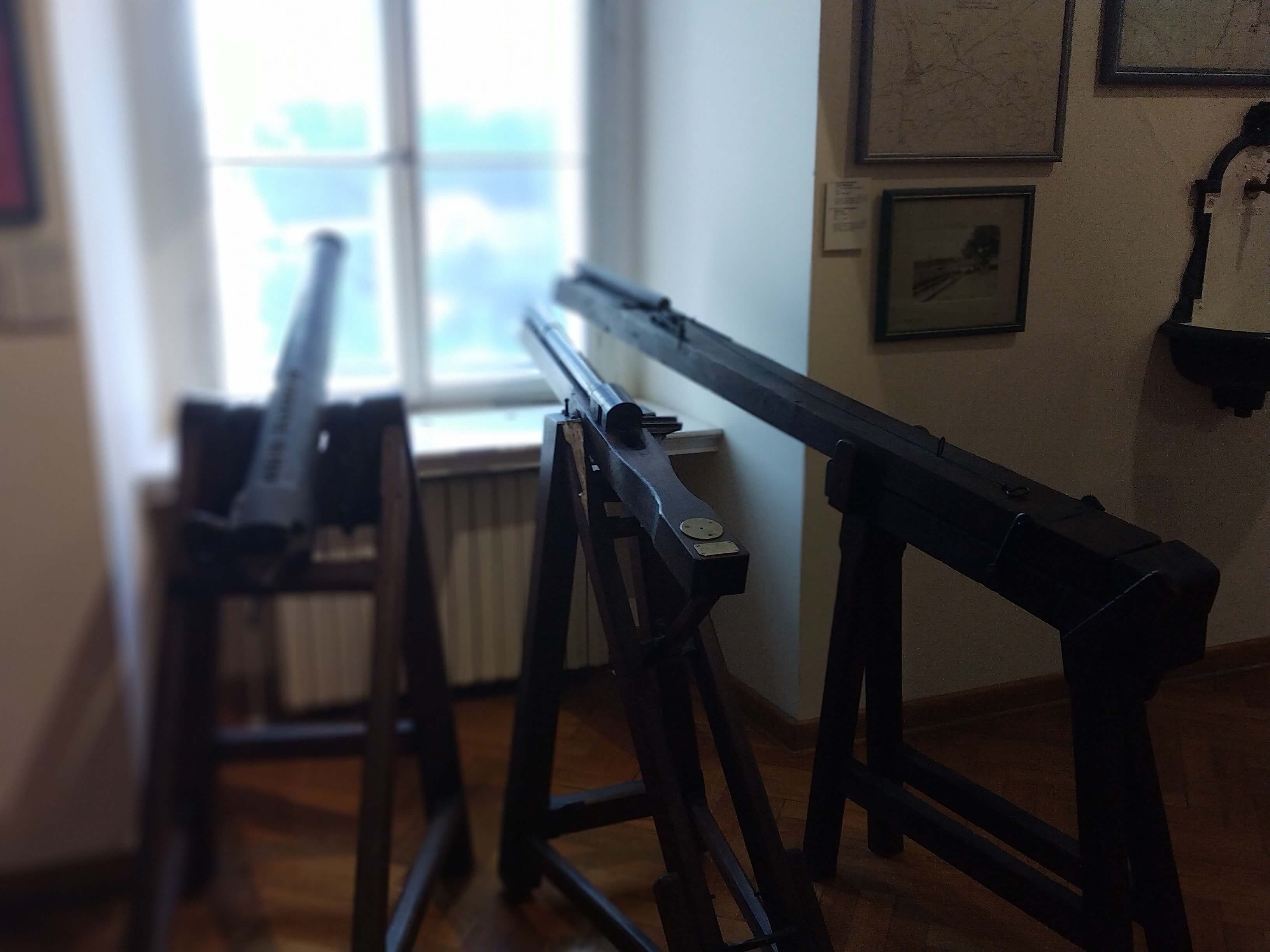
Three cannons showcased at Zagreb City Museum © Ivor Kruljac / Total Croatia News
So finding yourself in front of Fort Lotrščak (whose entrance is located right next to the Upper town funicular station) is not recognizable if you are not a fan of loud noise as it can give you a sound fright even down below at Jelačić square and the surrounding area. But, for the brave ones, the Grič cannon can provide a unique souvenir from Zagreb. It doesn't use live ammo (the cannon is modified so it can't), but it does fire several pieces of thick cardboard that then flies down to the area underneath Lotrščak's entrance and smelling like gunpowder.
Ceased fire
Despite being a regular background sound for the experience of living in Zagreb, Grič cannon went through periods when it ceased fire and stopped making statements. The first such instance was World War I and then followed by the war in the nineties. Most recently, the cannon was silenced after the Zagreb earthquake on March 22, 2020, but it re-fired hot and heavy sometimes in May 2020. However, followed by the December 29th Petrinja earthquake, which was also felt heavy in Zagreb, the cannon is silent even today.
„We are not quite sure when it will re-fire“, briefly commented the Zagreb Tourist Board member that welcomed me in Fort Lotrščak, one of the locations where Zagreb TB has a regular stand. Still, despite the cannon being silenced, you can climb and sightsee Lotrščak, the famous cannon as well as the watchtower on top of the Fort, for the prize of 20 kunas.

One of the exhibitions at Lotrščak © Kula Lotrščak
The Lotrščak Fort address is Tomićeva 9, and the Fort occasionally also hosts various exhibitions at times too. But, the cannon is a regular feature, and there are lots of info on the history of the cannon and the Fort itself there too on the walls- both in English and Croatian.
Learn more about Zagreb on our TC page.
For more about history in Croatia, follow TCN's dedicated page.
PM: Croatia Independence Day Historic Decision To Launch Separation From Yugoslavia
June 25th, 2021 - Prime Minister Andrej Plenković Friday congratulated Croatia Independence Day, observed today, saying that it was a memorial day marking parliament's historic decision to launch Croatia's separation from the former Yugoslavia.
By adopting the Constitutional Decision on Croatia's sovereignty and independence and the Declaration on the proclamation of a sovereign and independent Croatia on 25 June 1991, the Croatian parliament confirmed the plebiscitary would the Croatian people expressed at a referendum the previous May, Plenković said in his message.
We confirmed that freedom and independence, that centuries-long dream of the Croatian people, by winning in the Homeland War, he said, thanking Croatia's first president Franjo Tuđman and all defenders and their families "whose lives and sacrifice are woven into the foundations of Croatia's independence."
Plenković said that 30 years after the parliamentary decision which set the path towards independence, Croatia was a member of the EU and NATO, had chaired the Council of the EU, and was about to join Schengen and the eurozone, which he said were the remaining strategic EU integration goals on which the government was intensively working.
Today, faced with new challenges such as the COVID-19 pandemic, the effects of devastating earthquakes, climate change, and catching up with the fourth industrial revolution, we are committed to economic recovery, reconstruction, energy, green and digital transition, demographic revitalization, and reforms, Plenković said.
Crucial for making the economy more resilient to future threats and swift post-crisis recovery are the investments and reforms the government envisaged in the National Recovery and Resilience Plan. We obtained considerable funds at the European level.
Observing Independence Day, faced with numerous challenges, Croatia needs unity and to look to the future more than ever, he concluded.
For more news, follow TCN's dedicated page.
Friends of Croatia: UNICEF - Croatia an Example to the World When it Comes to Breastfeeding
May 27, 2021 - The sixth article in the "Friends of Croatia: UNICEF" series explores the work of the UNICEF Office for Croatia. What is done regarding children's rights in Croatia, positives, and negatives, and how can you help if you want to?
To ensure that our world even stays the same, let alone improves, new generations are essential. But, before they grow old enough to participate in society, society must first take care of the youngest ones to grow and develop. Society must ensure for kids that they grow up in families filled with love, make sure that kids can go to school, that they are healthy, safe from violence, that they are not hungry or thirsty, and give them overall opportunity to make it in the world.
Basically, children have rights, and they are in more detail elaborated in 54 articles. For more details, have a look at the Convention on the Rights of the Child that came to power on September 2, 1990, by the United Nations (UN) General Assembly.
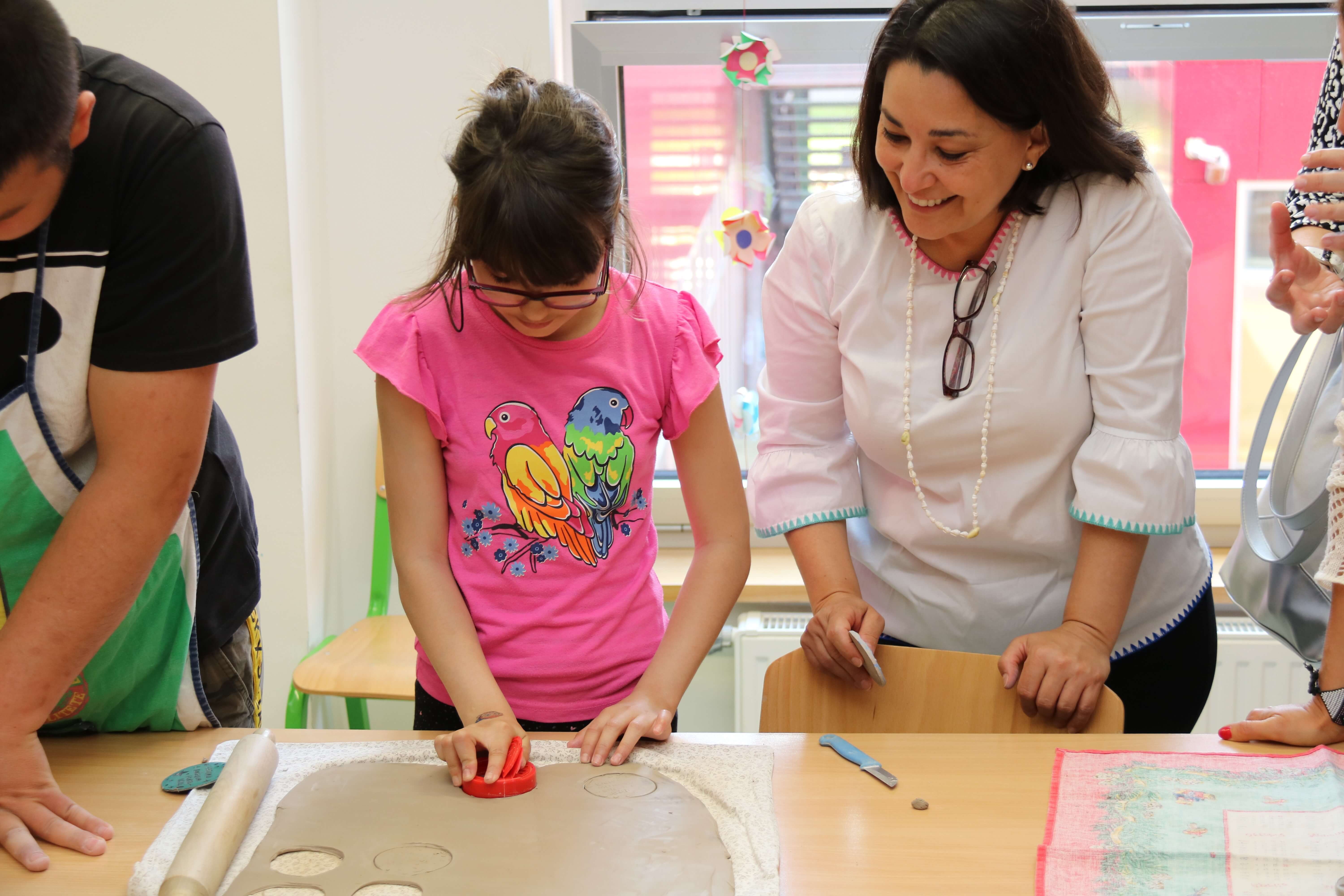
Regina M. Castillo, UNICEF office for Croatia representative with children with disabilities in Centre Tomislav Špoljar in Varaždin © Marin Ilej/UNICEF
The UN is dedicated to seeing this Convention is being respected, and United Nations International Children's Emergency Fund, commonly known as UNICEF, specializes in the issues of children's rights. Established in the aftermath of World War II, UNICEF has been at the frontlines of humanitarian crises, armed conflict, and natural disasters.
„Undeterred by the scale of the crises, we rise to the challenge, reimagine what is possible and respond by helping millions of children survive and thrive. Our on-the-ground expertise has reached more than 191 countries and territories, through committed partnerships and a passion for innovation“, says UNICEF on its official website.
Croatia signed and agreed with the Convention, and UNICEF today has its own office in Zagreb. Furthermore, it's worth noting that UNICEF has existed for 75 years, and despite firstly coming to Croatian territory while the country was part of the former Socialist Federal Republic of Yugoslavia, UNICEF has been with Croatia since the organization was established.
„Many people do not know that UNICEF helped to eradicate malaria in Croatia and that UNICEF played a key role in the development of modern dairy. Dairies were built in Zagreb, Rijeka, and Split, and factories for the production of powder milk in Osijek and Županja. Milk was distributed in schools, and for many children, it was their only meal during the day“, says Regina M. Castillo, UNICEF Office for Croatia representative.
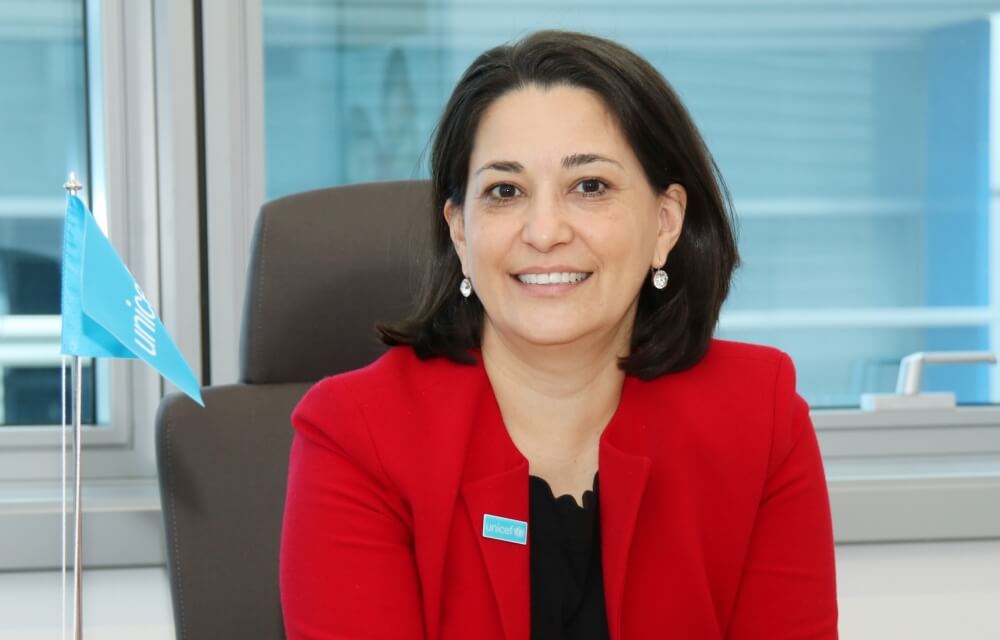
Regina M. Castillo, UNICEF office for Croatia representative © Marin Ilej/UNICEF
The UNICEF representative is elected for a five-year mandate, and Regina M. Castillo came to her function in Croatia in 2019. Her career in the UN started in 2001 and was in charge of economic and social questions in the Executive Office of the UN chief secretary Kofi Annan in New York. This was followed by Castilla moving to work in the mutual program for HIV/AIDS, known as UNAIDS. She was first the director of private sector partnerships in Geneva (2006-2012) and then moved to be the director for Bolivia, Ecuador, and Peru (2012-2015). She majored in International relations and public politics.
Born in Nicaragua, she first started her career in the 1990s as a diplomat, and she was also the headmistress for international trade in the Nicaraguan Trading Ministry.
Helping Croatia before it was cool (or an independent country)
Castillo went on to continue that after World War 2, UNICEF fed six million children every day, which included many children in Croatia.
„One of those children was our dear colleague, prof. Josip Grgurić, who is still working tirelessly for the youngest. He still remembers the yellow cheese that was part of UNICEF's humanitarian package for families, as well as the chocolate that he then tasted for the first time. He later worked at the children's hospital in Klaićeva, which UNICEF helped found, and he still works hard on UNICEF’s Child-Friendly Hospital Initiative“, says Castillo indicating how valuable but also inspiring UNICEF can be to children. Castillo added that in the Homeland War, UNICEF was the first organization on the ground, making sure that children and families received the necessary psychosocial support and humanitarian packages. After the war, they educated children on how to protect themselves from landmines.
Today Croatia developed, joined NATO and EU, and is a modern European country. With such progress, there have been many improvements in respect to children and their rights.
„Croatia has a low mortality rate of children under the age of five, extremely low stunted growth rate due to inadequate nutrition in the first years of life and the enrolment rate of children in primary school is almost 100 per cent“, pointed out Castillo.
„Croatia is an example in the world when it comes to the promotion of breastfeeding. It is rare that all public maternity wards in a country have the status of 'Child-Friendly Hospital'. With the support of UNICEF, partners have organized a network of breastfeeding support groups, and now we have more than 200 support groups in Croatia“, added Castillo on what the world can look up to this small South-Eastern European country.
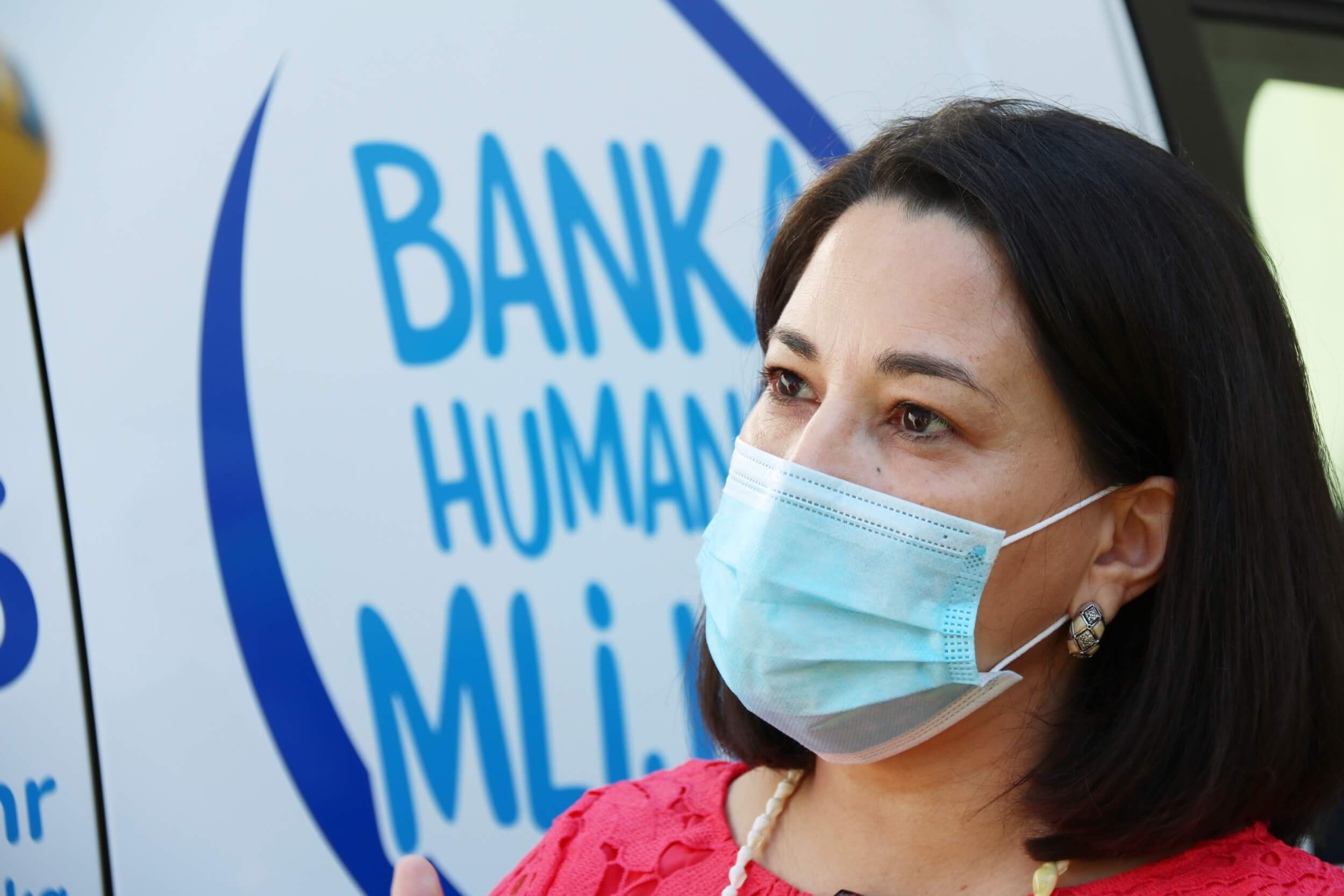
Regina M. Castillo at Human milk bank © Marin Ilej/UNICEF
Still, there are some issues Croatia needs to address and are far from ideal at the moment.
„There are still differences when it comes to access to services for children, depending on where they live and the conditions in which they grow up. Children with disabilities, as well as children from the poorest families, especially in rural areas, often do not have the opportunity to attend kindergarten and do not have the same access to specialized health services and therapies as children in urban areas. The focus of UNICEF in Croatia is on the most marginalized children: children with disabilities or developmental delays, children growing up without adequate parental care, children from minority groups, children at the risk of poverty and exclusion. UNICEF’s programs are focused on the well-being and protection of every child, with a special focus on the most vulnerable children“, pointed out Castillo.
Campaigns and programmes such as “Every child needs a family”, “The first three are the most important”, and “Stop violence among children” are perhaps the most known public action by UNICEF in Croatia, but returning to the good practices of breastfeeding, Castillo emphasizes the establishment of the Human Milk Bank in her current mandate.
„Thanks to the Human Milk Bank, prematurely born and seriously ill newborns (who do not have access to their own mother's milk) can receive milk donated by other mothers. We continually work on reducing the risk of disasters, support the development of quality foster care and provide support to parents in the upbringing and care of children through workshops and we work a lot with young people“, said Castillo.
In general, UNICEF has different types of offices in countries, and regarding the Croatian office, it’s a Country Office. In other words, most of the resources (human and financial) are invested in programs in Croatia. Castillo says that the five-year mandates have priorities that are determined in cooperation with partners. And while 80 percent of the funds raised are invested in programs for girls and boys in Croatia, there are funds and support programs for children outside of the country.
“For example, in 2018, UNICEF supported child health care in parts of Ukraine affected by the conflict and helped the building of five inclusive children's playgrounds in two refugee camps in Jordan in cooperation with the Ministry of Foreign and European Affairs in 2019. Through the ‘Schools for Africa’ program , which includes many kindergartens and schools throughout Croatia, UNICEF supports the education of girls and boys in Madagascar", Castillo listed several examples.
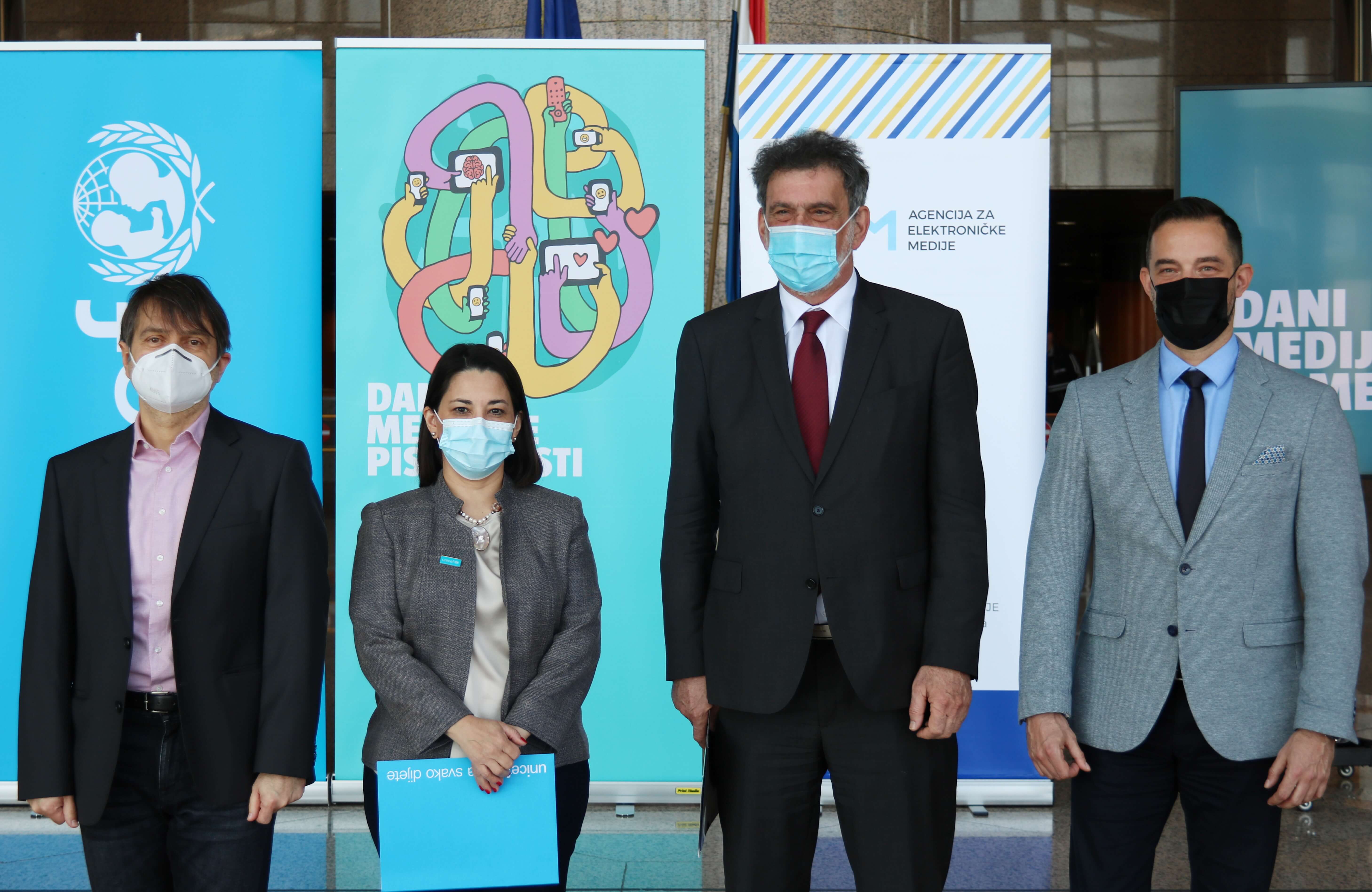
Regina M. Castillo, UNICEF office for Croatia representative with children on Media Literacy days press conference with Radovan Fuchs Minister of Science and Education, Krešimir Partl, State Secretary at Ministry of culture and media and Robert Tomljenović, Deputy Director of the Council for Electronic Media © Marin Ilej/UNICEF
Overall, the UNICEF Office for Croatia works closely with the Croatian Government, and most notably, with the Ministries of Social Welfare, Education, Health, and the Ministry of Foreign and European Affairs. Other partners also include experts (Croatian experts, but also building on expertise and good practice from all over the world), professional associations, academia, services providers, and NGOs.
“UNICEF’s goal is to connect all stakeholders and to advocate and support systemic change for the well-being of all children. System change is a gradual process, and it can be challenging, but when it comes to children’s rights, every step forward is well worth the effort”, explained Castillo.
Croatian citizens showing support for UNICEF
On one hand, Croatia is a good country with low mortality rates of kids and a role model for breastfeeding promotions. On the other hand, however, peer to peer violence (on whose suppression the aforementioned “Stop violence among children“ campaign works heavily on), and unequal approach to education between rural and urban areas show Croatia has both its ups and downs. Unfortunately. The downside sometimes overshadows all the positive things.
One such instance was the tragic death of a two-year-old girl from Nova Gradiška on Easter Sunday. The death of a severely injured girl, who was brought to Zagreb's children's hospital after suffering abuse and heavy beating from her biological parents (and from whom the girl was taken and given to a foster family but was then returned back to biological parents), sparked controversy and citizens outrage, culminating in changes in social welfare law, as well as sacks and investigations in the welfare center in Nova Gradiška.
„We are deeply saddened by the tragic death of two-and-a-half-year-old Nikoll on Easter Sunday. There are no words to express the pain of such a terrible event. Unfortunately, there are no simple and quick solutions to prevent violence against children. For years, UNICEF in Croatia has been continuously and persistently working in the field of child protection, educating experts from the social welfare system, but also other experts who work with children and families, such as experts from the health care, education, and justice systems. UNICEF implements various support programs for parents, and it is fully committed to the development of foster care and the improvement of the legislative framework. However, UNICEF is also aware that society as a whole, has a long way to go to achieve the goal that every girl and every boy is guaranteed the best possible care and protection. UNICEF will continue to work actively, persistently, and dedicatedly with all partners to achieve it”, commented Castillo.

Regina M. Castillo talking on Media Literacy days press conference © Marin Ilej/UNICEF
However, Croatians recognize the importance of the UNICEF mission. Before Covid, UNICEF annually collaborated with the Museum of Illusions on the Museum of Reality exhibition which displayed the problems children faced worldwide, but which also showed what changes and solutions UNICEF brought to those areas.
“Experience tells us that citizens are ready to support the youngest, in Croatia and beyond. Implementation of our programs would not be possible without the support from citizens and companies that placed the focus of their CSR activities precisely on children. We especially value the support from our Childhood Guardians, donors who support our work with regular monthly donations and allow us to regularly conduct our programs for boys and girls, as well as react quickly with much-needed assistance in crisis situations like the earthquakes in Croatia and the COVID-19 pandemic that affected all families. UNICEF is always in the field with the most vulnerable children and their families”, notes Castillo.
In the end is important to note, that while children are recognised as a particularly vulnerable group, all human rights apply equally to children.
“All the rights enshrined in the Convention apply to every child, regardless of a child’s country of origin, gender, religion, and nationality. Every child, by birth, has all his/her rights, the right to grow up in a safe environment, to have a family, to have access to health care and education, to be able to play and develop his/her interests and reach his/her full potential”, concludes Castillo.
The five-year mandate is an agreement that sets priorities in advance, so Castillo warned that there is no opportunity for making donations outside of that framework. UNICEF office occasionally does get messages from citizens who need advice or help on issues outside of that frame, but nevertheless, UNICEF can offer them help by referring them to institutions and addresses that can offer citizens the necessary support, financial support, or information.
With expertise mentioned several times throughout this story as the insurance of delivering the best solutions to issues children face, UNICEF is always on the lookout for new people. If you want to make a change in the world while earning a fair wage yourself, check out what expertise UNICEF is looking for right now.
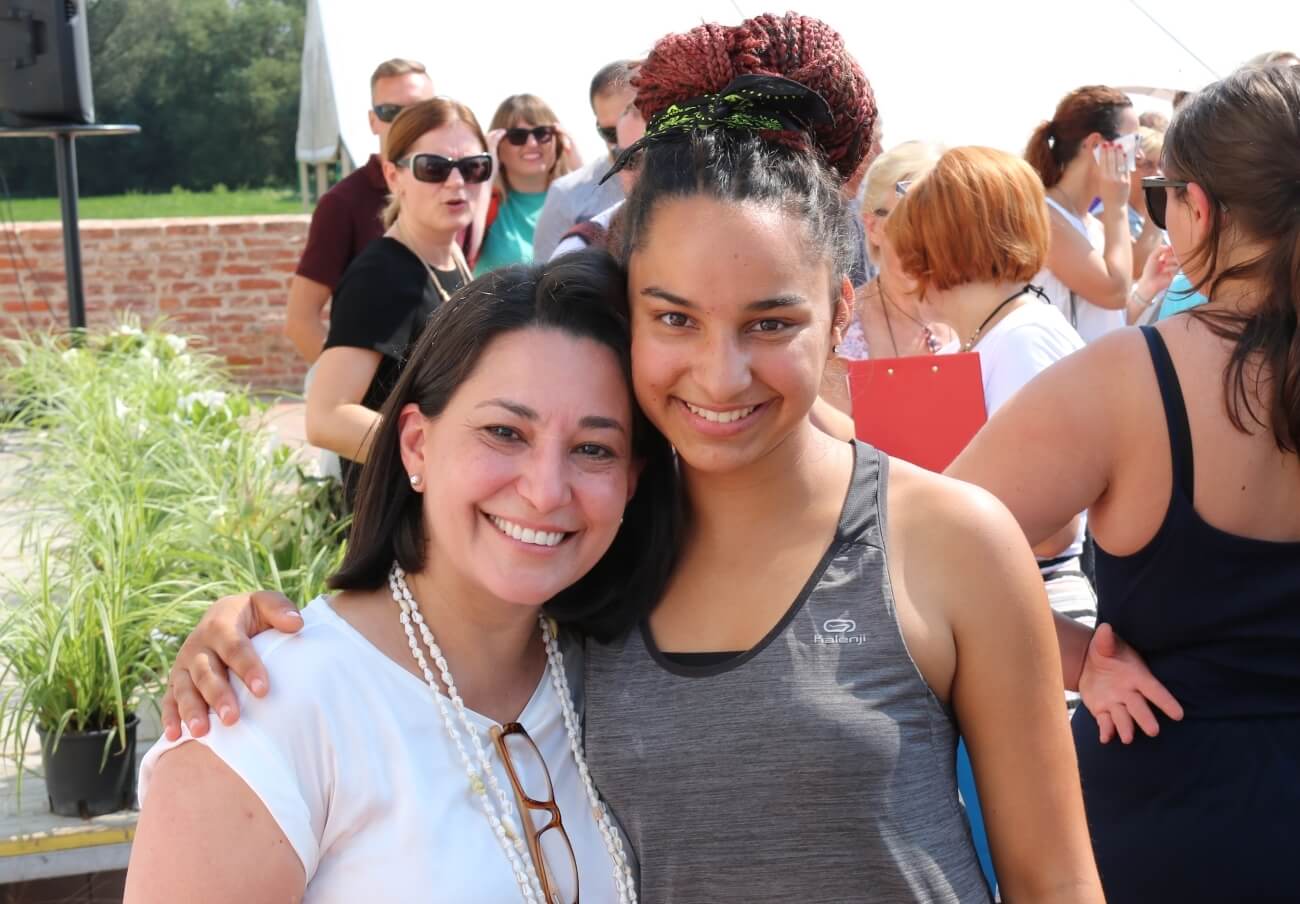
Regina M. Castillo on a foster family gathering © Marin Ilej/UNICEF
UNICEF Croatian Office is situated on Radnička cesta 41/7. To inform the public of their work, they built a considerable presence on Facebook, Twitter, Instagram, Youtube, and Linkedin. You can also find all UNICEF-related info for Croatia on their official website, and contact them via mail: This email address is being protected from spambots. You need JavaScript enabled to view it. or on phone numbers: +385 1 2442 660 and +385 1 2442 661. You can use the website to donate to a cause in Croatia too. Additionally, there are numbers: +385 1 4095 855, +385 99 2692 196, and +385 91 621 1039 for more details on donating to Croatia as well as e-mail address This email address is being protected from spambots. You need JavaScript enabled to view it.. You can also leave a donation to UNICEF in your will, and a phone number +385 1 3031 640 specializes for the issue in Croatia. If you find yourself in Croatia and you want to volunteer for UNICEF, more info can be found by sending a mail to This email address is being protected from spambots. You need JavaScript enabled to view it. and on phone number +385 1 3031 646.
And of course, you can donate for a good cause to UNICEF for any action the fund is internationally involved in.
To read more from the series "Friends of Croatia", follow TCN's dedicated page.
For more about UNICEF in Croatia, follow TCN's dedicated page.
Youth Day Marked in Kumrovec
ZAGREB, 22 May 2021 - Delegations of Krapina-Zagorje County, the town of Kumrovec, associations honouring Josip Broz Tito and the Alliance of Antifascist Fighters and Antifascists (SABA) on Saturday marked Youth Day by laying wreaths and lighting candles at a monument to Josip Broz Tito in his birthplace Kumrovec.
SABA leader Franjo Habulin said that this year, due to the coronavirus epidemic, people gathered in Kumrovec spontaneously to remember Youth Day as it had been and to agree on how it should be marked in the future.
"Youth Day is inextricably linked with Josip Broz Tito because it is marked on the day when Tito's birthday was officially celebrated and because Tito had a special relationship with young people, who had borne the brunt of the national liberation struggle in World War II as well as the burden of the post-war reconstruction of the country," Habulin said.
He added that the attitude to young people today was not as it should be, which was why they were looking for a future outside of Croatia, stressing that the current as well as future governments had the responsibility to create conditions for young people to stay in the country.
Jovan Vejnović, president of the alliance of associations honouring the Yugoslav communist revolutionary and statesman, said that it was frequently forgotten that in Tito's time the then Yugoslavia had changed from a backward country with a large share of illiterate people to "a serious European state."
"Before WWII 80% of Yugoslavia's population was illiterate and over a period of 25 years they were all made literate, we educated a cultural and technical intelligentsia that was on a par with intellectuals in the rest of Europe. That is something that made not only Tito's status as a leader of the Non-Aligned Movement important for this region, it made the country he represented important as well," said Vejnović.
For more news about events in Croatia, follow TCN's dedicated page.
Croatian Immortal: Meet Joža Manolić, Beating COVID-19 at 101!
May 12, 2021 - The way things are going, eternal life might be a reality for this Croatian immortal: meet Joža Manolić, second Croatian Prime Minister and the Yugoslavian secret agent that defeated COVID-19 in his 102nd year of life.
With corona spreading through the world like butter on bread, everyone needs to be careful, but especially people who are old and/or have chronic diseases.
So when someone close to 100 survives the infection, it's a news story worthy of international attention.
And, a similar case most recently happened in Croatia. As Index.hr reports, one man, who turned 101 two months ago was fighting with the virus for three weeks. He was never hospitalized but was under the doctor's close surveillance in his home until he finally recovered. And the story spread throughout Croatia as an amazing fight, but realistically, among Croatians, the winner of this epic battle of man vs. virus was known all along. Even when it seems the virus was taking the lead at one point, there was nothing to do but watch with a smug look and think, „He'll bounce back, that virus walked into Pfizer/AstraZeneca/Johnson&Johnson/Moderna cocktail embodied naturally". Despite being the priority for vaccination by all health standards, this corona patient didn't even took the vaccine because, as he said to the press „nobody invited him, and he was waiting for his turn“.
The victorious patient's name is Joža Manolić, and he is in Croatia what Rip Thorn is in the US (only Manolić is much cooler, sorry Rip).
If you are a paranoid doomsday awaiter, watching the Doomsday clock in panic, which, at the time of writing this article, showed 100 seconds until midnight, Croatians would say you are crazy. As long as Joža Manolić is alive, the world will keep spinning. The ultimate proof corona is bad, but not the end of us.

screenshot / NewsBar
Croatian James Bond but without replacement actors every few movies
Born on March 22, 1920, Joža Manolić isn't only the person that has seen it all; he has done it all!
He served as the second Croatian Prime Minister from August 24, 1990, to July 17, 1991, and is one of the founders of the Croatian Democratic Union (HDZ), but before that, he had an impressive carrier in the former Socialist Republic of Yugoslavia.
When he turned 18, he joined the League of Communist Youth of Yugoslavia (SKOJ) and was accepted into the Croatian Communist Party when he was 19. From then, among other things, he was appointed Secretary of the Municipal Committee of SKOJ for Nova Gradiška and was named a member of the Regional Committee of the Communist Party in 1940. When WW2 broke out, he was arrested by Ustasha authorities (of the Independent State of Croatia, an ally of Hitler and Mussolini) for spreading communist propaganda in Nova Gradiška. When released from captivity, he moved to Zagreb, where he started cooperating with Yugoslav Partisans and later moved to the partisan-controlled territory. Moving up in the ranks of communist circles, Manolić broke through the very top of the Yugoslav intelligence service. Firstly in OZNA, notorious for eliminating political opponents, and later to UDBA, which was less drastic but still pretty nasty secret service you didn't want to mess with.
The go-to guy to make history, the Croatian James Bond portrayed by only one man, bright and cool.
There is an expression for the fans of Hajduk Footbal Club that „Hajduk lives forever“ (Hajduk živi vječno). This may be true, but as their game performance shows, it's hard to be as successful in 110 years as Joža Manolić is in 101 years.
What is even more interesting, Joža Manolić was born in 1920, three months before the conclusion of the Spanish Flu pandemic, and his 100th birthday he celebrated in Zagreb, believe it or not, happened the same day, Zagreb was hit with a powerful 5.5 Richter scale earthquake. With two wars, eight epidemics, and several financial crises survived, Manolić is really the guy you want to be next to regardless of what horrible, death-guaranteed menace is heading your way.
Immortality recipe: healthy diet and… being a secret agent?
When famous Croatian satirist and editor of the hilarious Newsbar site, Borna Sor (who is not a stranger to TCN) interviewed Manolić in 2016, he asked „the then young 96-year-old Manolić“ how is it possible that he is still alive?
„Every secret agent either lives a long life or is killed ahead of schedule“, said Manolić in good humor.
As Jutarnji list reported, Manolić's DNA was even sequenced to scientifically research the secret of his long life in 2018. The Korean Biotechnology company doesn't really have a precise explanation of his long life, but Manolić has his entire genome on a memory stick, joining other famous people with such an honor, including Nobel prize winner James Watson, actress Glenn Close, TV host Larry King, rock star Ozzy Osbourn and several more. He is the oldest living owner of a driver's license (although he didn't extend it when he turned 100), an active driver, whose clean traffic record can put to shame much younger people causing havoc on the road, including controversial Croatian entrepreneur Tomo Horvatinčić. He was married twice, last time when he was 97 to a then-60year-old woman with whom he was a decade in a relationship. Today he is sadly a widow, outliving both of his wives.
Whether it's any famous Croatian personality or internationally recognized as Eddie Van Halen, Hugh Heffner, or Prince Phillip, there isn't a celebrity death in the country that isn't acknowledged with „Joža Manolić outlived him/her“. As you can imagine, there is an entire group on Facebook dedicated to jokes such as „We need to care for the environment to leave a nicer world to Joža Manolić“, or „Joža Manolić being in Eden before God“.
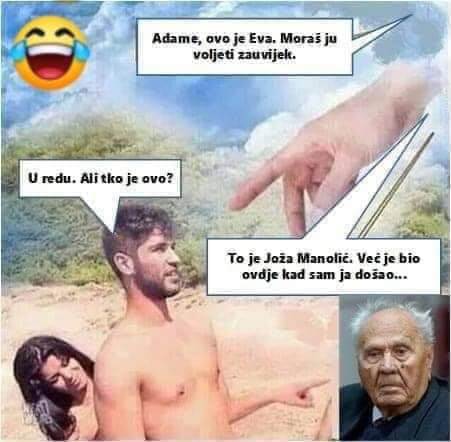
God explaining to Adam and Eve that he found Joža Manolić when he arrived © Joža Manolić je nadživio
Fascinating and publicly active, the author of this text really wanted to use the news of Manolić defeating corona to do an interview with him for TCN.
„Don't contact him for the love of god! He is over a hundred years old and just got over corona“, said my editor Iva Tatić pleading that I continue to bother diplomats and other people instead of one of the biggest living legends Croatia has ever known.
Well, maybe after he gets some rest from corona, there will be a chance for an interview.
Frankly, I don't worry Joža Manolić is going anywhere, but the question is will I live long enough to do the interview with this pristine gentleman that, while Zagreb has tons of fountains, kept the fountain of youth in his backyard.
Learn more about history and politics in Croatia on our TC page.
For more about legends of Croatia, follow TCN's dedicated page.
Best Zagreb Mayor By Historians: Historians Shouldn't Rate, But Većeslav Holjevac Takes Lead
May 11, 2021 - Ahead of the local elections, following the death of Milan Bandić and troubling issues Zagreb is facing at the moment, TCN reporter Ivor Kruljac wondered who is the best Zagreb mayor by historians.
With the local elections happening in Croatia this Sunday, just as every year, 2021 is no exception, with all eyes directed on Zagreb. This is no surprise, given that, for better or worse, Zagreb is the capital city, the center of politics, culture, science, education, and the spot where Croatians from other smaller towns, villages, etc. come in search of a job and new opportunities. You may not necessarily need to leave the country to leave your dreams, and despite other regions of Croatia slowly but surely developing, Zagreb is still considered by many as the necessary place to go to achieve something.
And this year, the eyes are even watching in even bigger suspense; Milan Bandić, who was the first man of the city for 20 years, passed away in February. The ever-controversial political figure (now replaced by his deputy Jelena Pavičić Vukićević, who also runs in the elections) suspected of corruption, being arrested during his mandate and on several trials, left lots of unresolved issues which the new mayor will have to address in the city's administration. Additionally, the current corona crisis caused some new challenges, and last year's earthquakes and city reconstructions are still a hot political topic among citizens.
Zagreb: History of overcoming the crisis
Challenging circumstances in 2021, no doubt, but certainly nothing Zagreb isn't used to. While settlements on the city's territory date earlier, the first mentions of Zagreb are linked with establishing of Capitol Diocese in 1094. Since then, diseases, earthquakes, floods various wars (WW1 and WW11 included, as well as the 90s war Croatians commonly refer to as the Homeland War), disrupt the peaceful life of Zagreb citizens. The city still stands. But of course, these different troubling contexts were handled not just by citizen's persistence but also by the city's authorities and leaders.
Throughout the turbulent history, Zagreb had, concluding with current deputy Jelena Pavičić Vukičević, a total of 53 mayors. The first one was as, Povijest.hr writes, Janko Kamauf, whose term lasted six years, from May 15, 1851, to 1857. He was a former city judge of Gradec, a title whose authorities basically made him the mayor of Gradec. Following the unification of rival Gradec and Kaptol into one city in 1850, he was elected to be the first leader of a city whose population at the time counted 16,036 people.
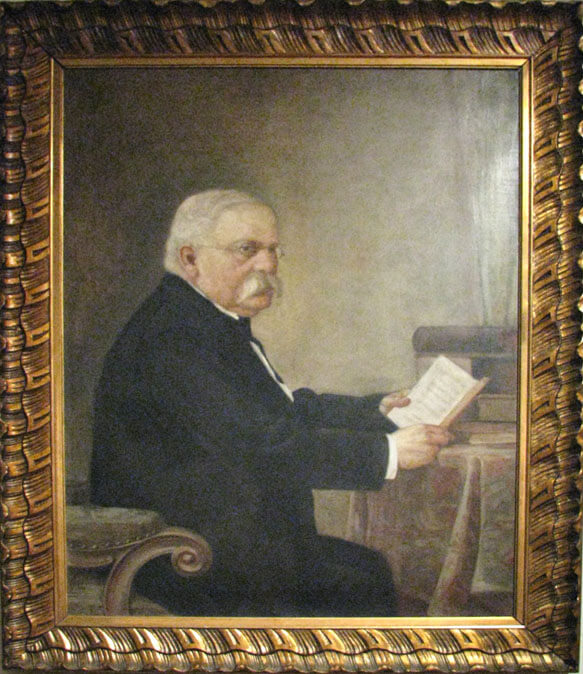
Janko Kamauf painted by Bela Čikoš Sesija, showcased in Zagreb City Museum © Unkown author, Wikipedia
He was the first, but was he the best?
I asked several historians if could they rate and pronounce in their opinion, with regards to the specific contexts, who was the best Zagreb mayor, from Kamauf to Vukičević Pavičić.
Two votes for Većeslav Holjevac!
„I'm not into grading, that's not a historian's task. Our task is to explain and put on the table facts and context of events“, said Ivo Goldstein when I asked him about the best mayor of Zagreb.
Ivo Goldstein may be best known to the Croatian public as a harsh critic of the far-right and the fascist regime of the Independent State of Croatia. As a Historian, he took an interest in various topics related to Croatian history.
At the start of his career, his focus was on Byzantine Empire and Croatian Middle Age History as well as the history of Jews in Croatia. In mid 90's he moved to the various aspects of Croatian history in the 20th century.
He was a professor of various history courses „General History of the Middle Age“ (1984-2003), history of methodology (1991-1996), and many more and today a full-time professor at the Department of History on The Faculty of Humanities and Social Sciences, the University of Zagreb (where he mastered and later completed his Ph.D. thesis at the Faculty of Humanities and Social Sciences, University of Belgrade).
Goldstein's scientific papers received positive acclaim in various countries worldwide, he hosted various projects scientific projects and associations and is very active in Croatian public space when it comes to historical issues that shape the ideas and decisions of current policies in Croatia.
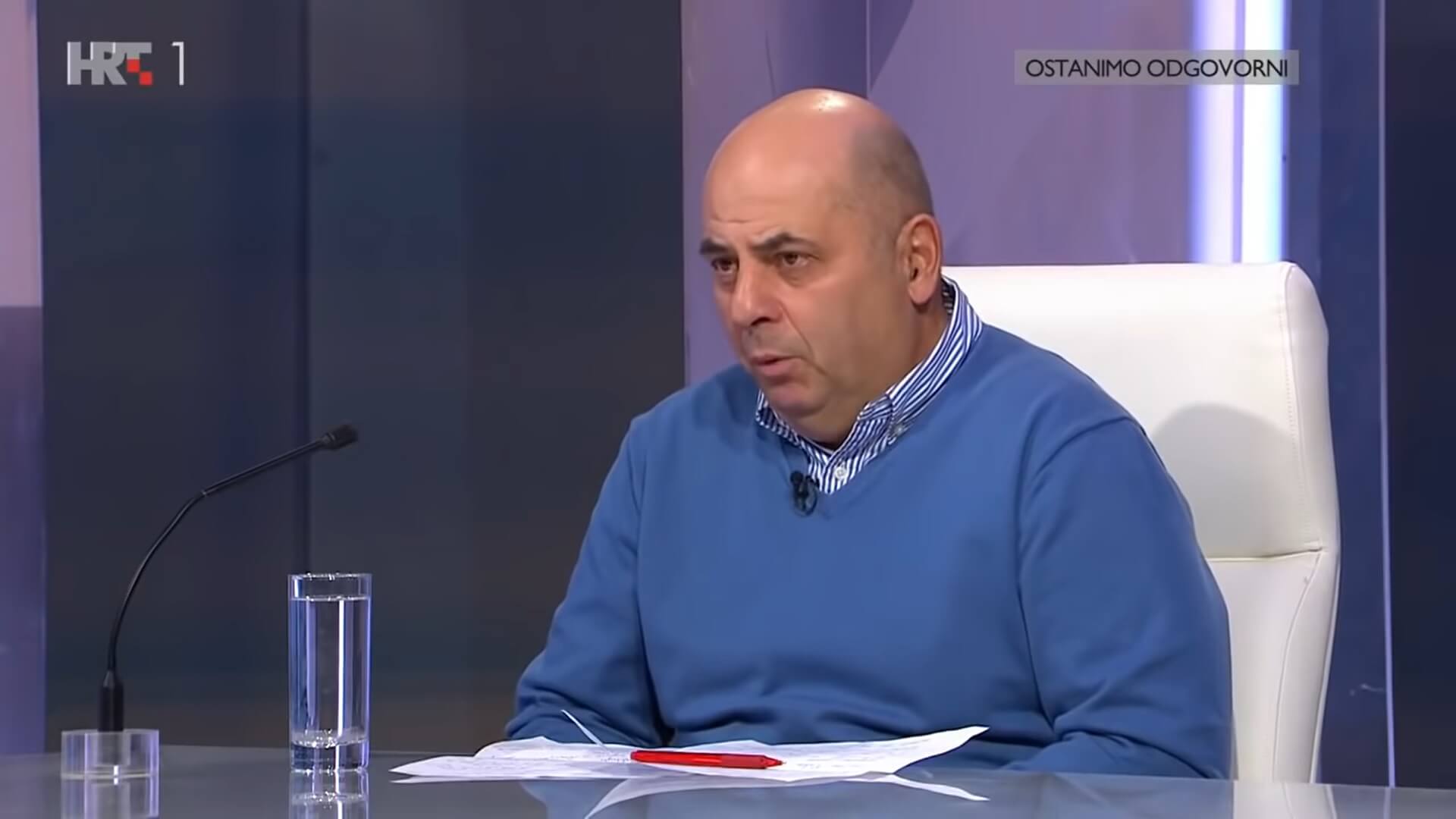 Ivo Goldstein / screenshot HRT Nedjeljom u 2
Ivo Goldstein / screenshot HRT Nedjeljom u 2
Upon explaining the role of historians, professor Goldstein nevertheless didn't mind giving his personal opinion.
„For me, there is no doubt that the best mayor of Zagreb is Većeslav Holjevac“, said Goldstein.
Većeslav Holjevac was the Mayor of Zagreb from 1952-1963 and his eleven-year mandate saw Zagreb develop and spread as the city.
„At that time, Zagreb was the capital city of Socialist Republic of Croatia, which was part of Yugoslavia. Holjevac saw a boost by liberal politics, it was the time of growth and optimism and Holjevac knew how to use it. He was a man of action and used Yugoslavia's opening to the world to Zagreb's benefit“, explained Goldstein.
He added that Holjevac didn't want to be perceived as some sort of transmission of higher state authorities. He didn't hide behind forums and was an independent, free-minded politician, which made him known and beloved among citizens.
„But it made him unloved among the higher power of authority which ended his mandate, although we historically don't know the real reason why Holjevac stopped being mayor“, Goldstein pointed out the mystery which is yet to be cleared up by historians.
The key term of Holjevac's mandate is the General Urban Plan which saw the development of the Most Slobode (Bridge of Freedom), expansion of Zagreb city to south across Sava river, and what today is Novi Zagreb (New Zagreb), as well as building up Zagreb Airport.
„Holjevac knew how to surround himself with good associates who were both dreamers and experts. Holjevac also engaged himself in the projects and his associates felt safe and that he got their back“, explained Goldstein.
The best example of that boldness and visionary approach can be seen in the Zagreb fair which was at that time located at the place of today's Student Centre in Savska.
„The fair needed expansion but was surrounded by railroad tracks everywhere, and the question was how to expand it. There were several options, but Holjevac decided to take it across the Sava river, and it happened. It was quickly constructed, and the first fair on newly build location was the Autumn fair in 1956. and it was the biggest event of its kind in the world back then“, said Goldstein, gladly adding he even had a chance to meet Holjevac as a 12-year-old since the mayor knew his father, an established Croatian intellectual, and politician, Slavko Goldstein.
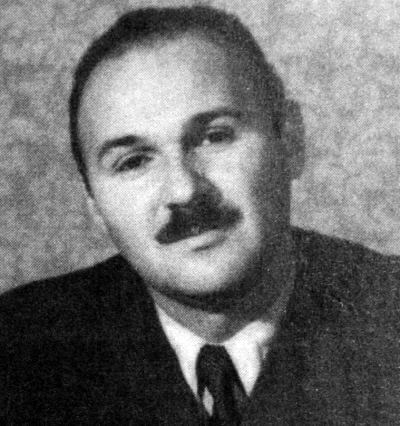
Većeslav Holjevac © Udruga Kameleon / Wikipedia
Hrvoje Klasić was professionally most occupied by Većeslav Holjevac, so he also shares Goldstein's opinion about Većeslav Holjevac.
„In a sentence: Zagreb has never been more developed as it was after Holjevac“, summarized Klasić.
Hrvoje Klasić graduated in 1997 from the Department of History, Faculty of Humanities and Social Sciences at the University of Zagreb. At the same University, he defended his dissertation entitled “1968 in Yugoslavia. Socio-economic changes in an international context”. Since 2003 he has been employed as a professor at the same Faculty and University.
Today, he holds a number of courses related to the world and national history of the 20th century.
Hrvoje Klasić also won the Annual Award of the Association of University Teachers and other Scholars in Zagreb in 2006. That same year he won the Annual Award of Sisak City for the Book „Croatian Spring in Sisak”. He is the author of 3 more books and the author of two documentary series „Croatian Spring“, and “The Independent State of Croatia” produced by Croatian Television. In 2017 The Serb National Council in Croatia gave him an award for the improvement of Croatian-Serbian relations. In 2019 he won the Award for the promotion of peacebuilding, nonviolence, and human rights.

Hrvoje klasić © Hrvoje Klasić
„Most people don't know that Holjevac technically wasn't a mayor, rather he was a president of the City's National Council“, explained Klasić the precision of the functions in the previous Yugoslavian state. He added that while his term lasted from 1952-1963, that is only partially true because he was first appointed to lead Zagreb in 1945.
„In 1945, he was named the city commander who was a military function but he was also in charge of food, traffic, working with several refugees after World War 2 until he gave the control over to civilian bodies“, describes Klasić.
Holjevac then moved on to be the minister of work and traffic in the Social Federal Republic of Croatia. However, at that time, Yugoslavia was going under a change in its political institutions by the self-governing policy which went under parole „factories to workers, cities to citizens“, and as a result, Holjevac 's ministry was shut down. His return to the top position in Zagreb happened without him even knowing.
„As part of self-governing, the Communist Party in Zagreb searched for someone who isn't just going to execute orders from above but instead is an individual that has quality, creativity and will make its own decisions. Holjevac was elected during a meeting he wasn't even present on, and some members of the party were worried is it smart to give Zagreb to a person who is from Karlovac“, said Klasić.
As Goldstein already mentioned, his term lasted over a decade, and Klasić adds that was a very unusual duration at the time.
While Goldstein already mentioned the traffic connections of Zagreb, Klasić said it is very hard to count everything Holjevac built, but he put focus on the industry. Industrial plants of organic-chemical industry, Zagreb heating plant, industrial plants of Pliva pharmaceuticals, Chromos paint company, Kemika, Zvijezda company, Katran, Badel company for alcohol spirits, an ice rink on Šalata, winter pool and gymnastics gyms on Mladost, Yugoton record company, Jadran Film, TV tower on Sljeme, Zagreb drama theatre, an emergency room in Draškovićeva, various elementary and high-schools, and began construction of Vatroslav Lisinski concert hall and more.
„Before Holjevac, there were 40,000 workers in Zagreb. After Holjevac, there was 110,000“, said Klasnić to illustrate the results which made the city the strongest industrial center in Yugoslavia. Apart from industry, Holjevac put a lot of focus on culture and education, as evident by building Workers University Moša Pijade for adult education (today's Public Open University Zagreb) and culture.
Holjevac's „Jump over Sava“ was done on the one hand to prevent interventions in old Zagreb, and on the other, the organizational construction of Novi (New) Zagreb saw the workers live close to the newly built factories.
As Goldstein already referred to Zagreb Fair as perhaps the most significant project of Holjevac's mandate, Klasić added that the unique geopolitical position of Yugoslavia as the bridge between east and west, thanks to the non-aligned movement, made the fair a key place worldwide.
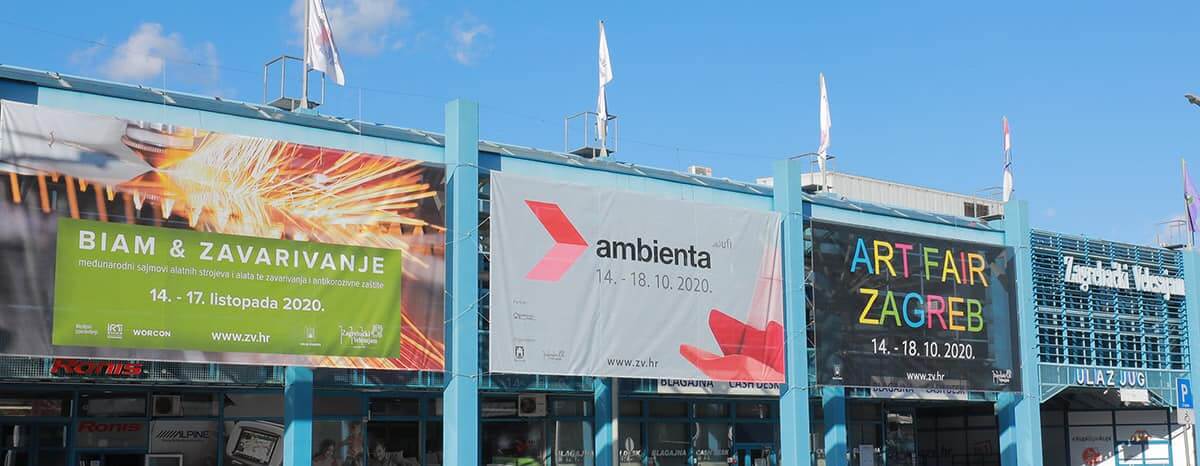
Southern entrance of Zagreb Fair in 2020 © Zagrebački Velesajam
„The fair was not just important for holding exhibitions, but for making deals and signing contracts as well. Given Belgrade was the capital of Yugoslavia, there were pressures to have such a fair there, and there were even boycotts from Belgrade to Zagreba Fair events. However, Holejvac being both persistent and enjoying support by the Yugoslavian president Marshall Josip Broz Tito, managed to keep this significant place in Zagreb“, explained Klasić.
When asked about resentment of other politicians, and the unclear mystery of concluding his mandate, Klasić said he had a chance to look at archives about Holjevac while working on an exhibition about him, and he feels that the situation is much simpler.
„Holjevac basically left due to the same politics that got him to be the mayor in the first place. The Self-Governing model started descending to the lower levels of the system and started searching for creative people. In 1963, a new constitution was brought that further developed the political system to give City Assembly more power accenting the community governing Zagreb. Holjevac's president of City's National Council title has shut down, and the president of Assembly became the first man of Zagreb.
Rotation of politicians as well as limited mandate time was arranged too“, explained Klasić.
He added, however, that it is problematic that an experienced, capable, brave, and brilliant man like Holjevac wasn't put to better use after he stopped being mayor and played bigger roles in Yugoslavian political life.
There isn't the best, only good and bad mayors
Unfortunately, other historians, I contacted (and of course, I couldn't contact every single one, who knows who else might be interested to participate), didn't respond to my inquiry. While Ivo Goldstein explained rating mayors isn't historian's job, Stevo Đurašković, professor at the Faculty of Political Sciences in Zagreb, further elaborated the problem of my question.
„I'm not a fan of such an approach to the topic like it's a miss pageant. In Zagreb's history (as in good portions of cities around the world). There were several great mayors, again, each in its own historical context“, explained Đurašković.

Stevo Đurašković, screenshot / N1
Stevo Đurašković is an Assistant professor at the Faculty of Political Sciences, University of Zagreb, where he teaches courses in politics of history and Croatian history. He received his Ph.D. in Political Science from the Faculty of Social Sciences at the University of Ljubljana and his MA in Central European History from the History Department at the Central European University, Budapest. His research interests include the politics of history, intellectual history, and national identity-building processes in East-Central and Southeastern Europe. Recently he published the book The Politics of History in Croatia and Slovakia in the 1990s (2016). Participated in several international projects, including “Identity Reader: Regional Identity Discourses in Central and Southeast Europe, 1775-1945” (CAS, Sofia). He is a member of the editorial board of the Cultures of History Forum (Imre Kertész Kolleg, University of Jena). In 2009/2010. He was a Ph.D. research fellow at the Faculty of Economic and Social Sciences, Comenius University, Bratislava (CEEPUS grant, Visegrad Fund grant).
In other words, an expert in his respective field with a valid and knowledgeable opinion.
„Milan Amruš and Većeslav Holjevac were great mayors. How to determine if Amruš's development of pre-war Zagreb is greater than Holjevac's post-war development of Zagreb?“ concluded Đurašković his decline to comment who would be the best mayor of Zagreb.
Speaking of Amruš, he was Zagreb mayor in two separate mandates, the first one lasting from 1890 to 1892 and the second from 1904 to 1910. Lice Grada reports that some of the accomplishments in Maruš terms include electrification of the city, and building up Munjara Power Plant (in 1906 and 1907). Under Amruš's mandate, the website continues, horse trams were replaced by electric trams in 1909 and new tram lines and the expansion of the previous one from Ilica to Topnička Barracks were constructed. In addition, 1890 saw lower and upper Zagreb connected by a funicular.
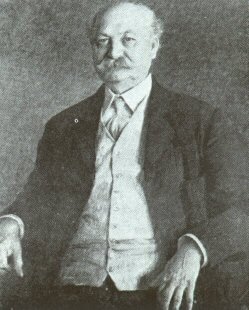
Milan Amruš © Unknown author Wikipedia
Đurašković also added in his decline that Pero Pirker is often „a forgotten mayor“, and Klasić mentioned him as the Holjevac's successor. Mentions of Pirker are also noted on Nacionalne Manjine (National Minorities) site that declared Pirker as a noted Zagreb mayor.
"There is no doubt that Pirker is one of the most capable, most successful, and in its time an extremely popular mayor. But it is stunning that for political reason, considering he was one of the established champions of Croatian Spring in 1972, his work was completely silenced not only until the 1990s but also later“, wrote Goran Beus Richembergh for Nacionalne Manjine.
It's worth noting that the Croatian Spring was a reawakening of national identity which paved the way for the country's independence and the dissolution of Yugoslavia, on which TCN reported on its 50th anniversary earlier this year.
In Pirker's time, the Great flood that sank Zagreb in 1964 was truly the historical challenge of his mandate.
„It was a natural disaster of great extent, and the entire previous state (Yugoslavia) was involved in sanitation and help was arriving from all over the world. But, the biggest responsibility for the coordination of help, sanitation of the damage, taking care of the casualties, and building new homes was carried out by Zagreb's authorities, lead by Pirker who showed to be a skillful manager and successful in various projects“, described Beus Richembergh.
Amruš had the challenge to electrify Zagreb to keep up with other European capitals, Holjevac had the challenge of restoring and developing the city post WW2, and Pirker had the flood.

Pero Pirker (on the left) © Croatian Journalist Association / Wikipedia
Both corona and earthquake, as well as the mess suspected to find post-Bandić, are all just another challenge in the history of a town that is used to be challenged and always dancing victory laps.
While Đurašković explained comparisons of what was the most difficult challenge and who was the best mayor make no sense, Goldstein and Klasnić presented their pick. But, as respectable historians they are, they emphasized that it is their opinion and not an empirical fact, even though their arguments are both knowledgable and well explained.
In the end, politics should be about making people's lives better and not about chasing crowns or historical acknowledgments. And as Zagreb really needs a quality leader, the only logical conclusion is: may the best candidate wins, and may purgers recognize the best man or women for Zagreb to once again wave the middle finger to the aftermaths of the recent crisis as it overcomes them.
Learn more about Zagreb on our TC page.
For more about history in Croatia, follow TCN's dedicated page.


